The Word Memorial.
How may one define the term Memorial? The Concise Oxford Dictionary puts it this way:
"Serving to commemorate; of memory. Commemorating those who died on active service."
In Australia, the commemoration for those who have died or served their country in time of war wears many different faces.
The Federal Level.
At the Federal level, there is the quite magnificent and world class, unique Australian War Memorial located in our National Capital at Canberra. It houses exhibitions about the various wars Australians have fought in, and displays a listing of those who have died serving their country. An unknown serviceman was laid to rest within the Memorial.

Australian War Memorial, Canberra
Also in Canberra are individual memorials or plaques for Nurses, Merchant Sailors, for ships and units from the three Services.

The Tomb of the Unkown Australian Soldier killed in the war of 1914-1918.
At the Australian War Memorial Canberra
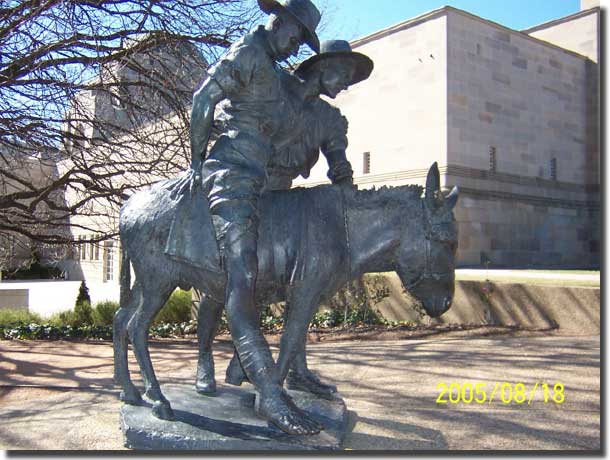
Simpson and his Donkey outside the Australian War Memorial
State Level.
Each State of the Commonwealth has its Cenotaph or war memorial. In Victoria, the Shrine of Remembrance proudly stands on its own hill looking towards the centre of Melbourne. It has an eternal flame burning in memory of Victorians who fell serving their State and country. It is the venue for the annual Anzac Day Service after the march of Veterans terminates there.
At the present time, a multi-million $ development of the under croft is going on, it will feature a wall display which replicates all the medals struck to honour those who have served.
Returned Servicemens League Clubs.
Across the country, are numerous RSL Clubrooms, every country town will have its RSL, and in the suburbs and Capital Cities these RSL Clubs flourish, particularly with the advent of the poker machine.
A display of war medals and other suitable memorabilia all serve to recall service down the years covering all the wars that our men and women have been involved in. At sunset daily, the ODE will be recited to remember those who died on active service.
Country Town War Memorials.
When visiting or just passing through our country towns which are scattered across the width and breadth of this land, one will always see, usually in the main street, a memorial to those who came from the town, went off to war, but did not come home.
This particularly applied for WW1, a list of those who died is displayed, highlighting the absolute decimation of the young men from country towns. During WW1 the total male population in Australia was but 2.7 million, 400,000 men volunteered for service. Of these, some 60, 000 died in France or at Gallipoli, this represents a death toll of 15%.
It is indeed a wonder that the country towns of Australia ever recovered or managed to carry on, so great was the carnage amongst its young.
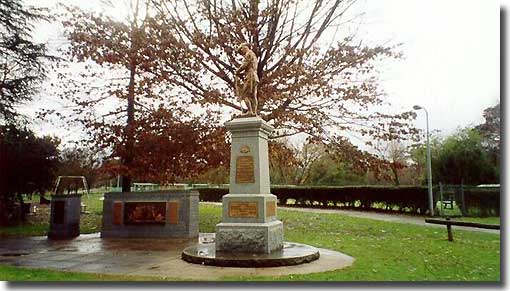
The Alexandra Soldier's Memorial.My wife Denise was born in this Victorian Country town
Ships as Memorials.
A number of Royal Australian Navy ships have been preserved to remember those who both served and died in them at sea.
HMAS Vampire is moored at Darling Harbour in Sydney, in Melbourne at Williamstown, the old corvette HMAS Castlemaine has been lovingly restored by a dedicated band of ex sailors and ship lovers.
In South Australia, at Whyalla, the corvette carrying the name of that city stands proudly high and dry, no longer afloat, but awaiting visitors to explore it, including small children to rush about its decks above and below the old waterline.
Museums.
Local Maritime Museums around the country act in their own small way as memorials to those who served at sea. Two examples will serve, one at Geelong in Victoria, and another in the northern New South Wales town of Ballina, both proudly displaying a multitude of exhibits pertaining to the wars fought at sea.
The Written Word.
There are numerous books, magazines, monographs etc all written to denote the exploits of the men who manned the aircraft, fought the ships, and filled the army units over all the wars that have found Australians rallying to the colours, these recall those who served both living and dead.
The Internet.
The Department of Veteran's Affairs have recently published a million names of servicemen and women on the internet. Each name recording the individual service of those from the three arms of the services. It too acts as a written memorial and record of dedicated service.
AHOY. Mac's Web Log.
In its own humble way my web site is dedicated to all: " Who went down to the sea in ships" but especially to the " 84 Officers and Sailors who died in HMAS Canberra on the night of the 9th. of August 1942, at the Battle of Savo Island."
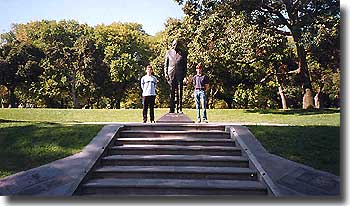
Sir Edward Weary Dunlop statue Melbourne Gardens
Individual Statues, and Memorial Parks.
In Melbourne, we have a statue to that legendary and heroic figure, Sir Edward Weary Dunlop, who performed miracles as a Doctor and Prisoner of War of the Japanese, on the infamous Burma Railway. No doubt his skills saved the lives of many his fellow POW"s. A small bronze statue of Simpson and his Donkey graces the precincts of the Shrine Of Remembrance in Melbourne, to recall their saving of many lives on the slopes of Gallipoli in WW1.
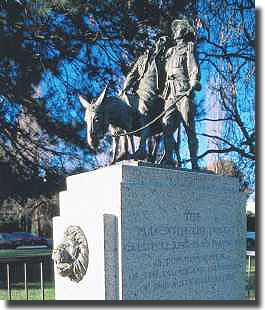
Statue of Simpson and his Donkey, Melbourne
(read more halfway down the page)
A number of Memorial parks exist across the country, each in its own way a daily reminder of the sacrifices made over many years in foreign lands many miles from home. One in particular, is Shropshire Park at Ulverstone in Northern Tasmania, the site of a recent reunion for wartime members of the crew of the heavy cruiser HMAS Shropshire, we were back to recall the time she commissioned as a ship of the RAN 60 years ago.
This park has now become a Naval Memorial to many of the Australian Navy ships, and also has, at the Corvette memorial, a large plaque devoted to the story of the sacrifice of young Tasmanian Ordinary Seaman Teddy Sheehan, who went down with HMAS Armidale, trying to save some shipmates from a devasting Japanese air attack.
Film and Photographic Archives.
In this archives are thousands of still photographic pictures, and a great deal of film which record activities of war and the personnel involved for posterity.
The Recording of 20,000 hours of Veteran's Oral History on film.
The present project of recording on film the oral history of veterans involved in WW2, has commenced, and I was priviliged to be the first to be interviewed in the state of Victoria. This initiative of the Department of Veteran's Affairs will go a long way in acting as a Memorial of their service, and will be available for future historians who wish to research this oral history of WW2.
Churches and Chapels.
Many of our Churches and Chapels have laid up Colours from the Services, and some display stained glass windows dedicated to ships, their crews, and to individual service people.
In particular, at Flinders Naval Depot, the Anglican Chapel features much of the work of Commodore Dacre Smyth, who has crafted some beautiful windows commissioned by Sailors who served in specific ships. Dacre donating his time freely to these works of art.
The Naval Chapel at Garden Island in Sydney features brass plaques to individual Officer and Sailors who have died, and they record each one's service to the RAN. Upstairs, the Chapel has complete windows depicting various units of the RAN that sailed the seven seas both in peace and war.
Cigarette Cards.
Over the years, the now defunct practice of including a card inside a packet of cigarettes was one mode of remembering both individuals and specific incidents during wartime. In fact, when I was a Midshipman, a photograph of me on watch on the quarterdeck of HMAS Australia in September of 1939 was reproduced in one of those series.
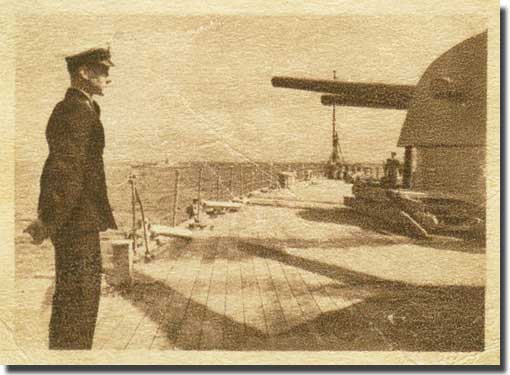
Photo of me in the Empire Defence Series, titled "Midshipman on watch, Australian Navy."
Avenues of Honour.
In a number of cities in Australia are Avenues of Honour, each tree replete with a small brass plate naming some serviceman and his record.
Anzac Day Services and Marches.
The 25th. of April each year, is a special day in the Remembrance Calendar of Australia. It recalls that first Anzac Day in 1915, when both Australian and New Zealand troops stormed the beaches of Gallipoli in far off Turkey.
In all Capital Cities, in the suburbs and in country towns, veterans meet, to march to a specific Memorial. once assembled, a short service of remembrance is conducted. It is a special day to meet up with old mates from the war, to swap stories of how we won etc, but above all to remember our friends who did not come home, or who have since died.
Conclusion.
War Memorials to remember the service of those who died or served in time of war to keep our country free are many and varied. I have most probably but scratched the surface of this subject, but this article serves to remind us all " That the cause of freedom " carries a high price, very often it proved fatal for many, and we need to continue to recall with pride and gratitude, the service of those who did not return.







